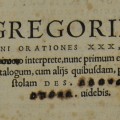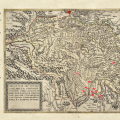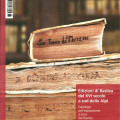Sede: Biblioteca Salita dei frati Lugano
Organizzazione: Centro di competenza per il libro antico
Nei primi decenni del Cinquecento, Basilea è un importante centro culturale, dove l'editoria si sviluppa grazie a stampatori locali (come Isengrin e Oporinus), e a stampatori giunti in città da altri paesi (come i tedeschi Froben e Petri). A Basilea arrivano anche rifugiati italiani che diventeranno a loro volta editori e diffusori di cultura (come Pietro Perna).
La mostra intende riunire e presentare una scelta delle edizioni di Basilea, oggi distribuite in varie sedi, che erano conservate nelle biblioteche della nostra regione nei secoli precedenti gli incameramenti ecclesiastici dell'Ottocento.
La scelta dei libri è stata effettuata non tanto con criteri di rappresentatività della ricca e importante produzione delle tipografie basilesi (non le edizioni più belle o più famose quindi) ma piuttosto per la loro collocazione in biblioteche ecclesiastiche.
Viene messa in risalto la diffusione di opere umanistiche in territori considerati all'epoca culturalmente arretrati, e la presenza di testi editi in una città riformata in un contesto di confessione cattolica. Dai primi Indici dei libri proibiti, a metà Cinquecento, molti autori e molti testi vennero banditi dalle biblioteche religiose, ma in molti casi semplici stratagemmi permisero di evitare i divieti, e ai libri di essere letti e conservati nei fondi conventuali, dove sopravvivono.
È stato pubblicato un catalogo della mostra che è in vendita ed è ordinabile tramite e-mail a bsf-segr.sbt@ti.ch.
Venue: Biblioteca Salita dei frati Lugano
Organisation: Centro di competenza per il libro antico
In the first decades of the sixteenth century, Basel was an important cultural centre where the publishing trade developed, thanks to local printers (like Isengrin and Oporin), and to printers coming to the city from other countries (such as the Germans Froben and Petrin). Also, Italian refugees who arrived in Basel would in their time become publishers and propagators of culture (such as Pietro Perna).
The exhibition intends to reunite and to present a selection of publications from Basel that today are distributed in diverse locations, while having been conserved in libraries of our region for centuries, prior to the ecclesiastical confiscations in the nineteenth century.
The selection of books was carried out not so much with a criterion of representing elaborate and important productions of Baselese tipography (thus, not representing the most beautiful or most famous publications), but chosen rather for their collocation in ecclesiastical libraries.
Special emphasis is put on the circulation of humanistic works in territories considered in this epoch to be culturally backward, and on the presence of texts published in a Protestant city within a context of the Catholic faith. From the first Indexes of prohibited books, in the middle of the sixteenth century, many authors and many texts were removed from religious libraries. However, in several cases they could avoid being prohibited through simple strategems that allowed these books to be read and conserved in conventual collections, where they have survived.



